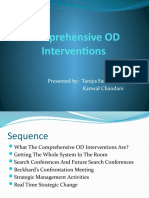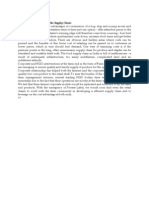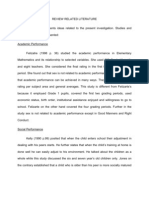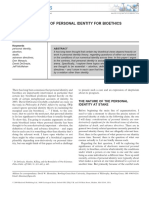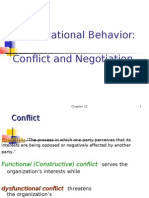Organisational Development & Change
Organisational Development & Change
Uploaded by
vicky3230Copyright:
Available Formats
Organisational Development & Change
Organisational Development & Change
Uploaded by
vicky3230Copyright
Available Formats
Share this document
Did you find this document useful?
Is this content inappropriate?
Copyright:
Available Formats
Organisational Development & Change
Organisational Development & Change
Uploaded by
vicky3230Copyright:
Available Formats
Organisational change is the process by which Organisation move from their present state to some desired future state
to increase their effectiveness. Forces/causes of Change (AT.607) External: Globalization Workforce diversity Technological changes Government policies Scarcity of resources Competition
Internal: Organisational silence Crisis/strikes Changing employees expectation Change in the work climate.
Process of change (AT.614) Need for change Recognizing the need for change Diagnosing the problem Planning the change Implementing the change Managing the resistance Follow up on the change
RESISTANCE TO CHANGE Although organizations initiate changes in order to adjust to the changes in their environments but people sometimes resist them. Therefore, managers need to recognize the manifestations of resistance both in themselves and in others, if they want to be more effective in supporting change. For example, managers can use the list given in following table.
Acceptance
Enthusiasm Cooperation Cooperation under pressure from management Acceptance Passive resignation Indifference
Indifference
Apathy: loss of interest in the job Doing only what is ordered Regressive behavior Non-learning Protests Working to rule Doing as little as possible
Passive Resistance
Slowing down Persona! withdrawal (increased time off the job) Committing "errors" Spoilage Deliberate sabotage The sources of resistance to change within organizations are classified into organizational sources of resistance and individual sources of resistance. Active Resistance
ORGANIZATIONAL SOURCES OF RESISTANCE Over determination or structural inertia refers to the tendency of an organization's rules, policies and structure to maintain the existing conditions and therefore resist change even when change would benefit the organization more than stability. When an organization tries to change one of its division or part of the division without recognizing the interdependence of the division with other divisions of the organization, then it is said to have a narrow focus of change. Often a part of division cannot be changed without changing the whole division. Group inertia may weaken an individuals attempt to bring about change. Resistance may also take the form of threatened expertise if the change lends to weaken special expertise built after years of experience. Organizational restructuring that involves reducing the number of job categories often meets this kind of resistance. Any change that may alter the power relationships within an organization may meet the form of resistance known as threatened power. Resistance may occur when a change threatens quantum of resource allocation from one part of the organization to another.
Individual Sources of Resistance Simple habits create a lot of resistance. Most people prefer to do their work the way they did it last week rather than learn a new approach. Perhaps the biggest cause of employee resistance to change is uncertainty. In the face of impending change, employees are likely to become anxious and nervous. They worry about their ability to meet new job demands therefore, leading to feeling of job insecurity. Some people resist change to avoid feeling of loss. For example, many organizations change interventions and alter work arrangements, thus disrupting existing social networks. Social relationships are important to most people, so they resist any change that might adversely affect those relationships. Change may also threaten people's feelings of familiarity and self-confidence. People may resist change because their perceptions of underlying circumstances differ from the perceptions of those who are promoting the change. OVERCOMING RESISTANCE TO CHANGE Managers need not abandon planned change in the face of resistance. Before recommending specific approaches to overcome resistance, there are three key conclusions that should be kept in mind. First, an organization must be ready for change. Second, the top management should inform the employees about the process of change. Third, the employees perceptions or interpretations of a change should be considered. The following methods of overcoming-resistance to change are as follows: Participation: Participation is generally considered the most effective technique for overcoming resistance to change. Employees who take part in planning and implementing change are better able to understand the reasons for the change than those who are not involved. They become committed to the change and make it work. Employees who have the opportunity to express their own ideas and to understand the perspectives
of others are likely to accept change gracefully. It is a time consuming process. Education and Communication: Educating employees about the need for and the expected results of an impending change help reduce their resistance. Managers should maintain an open channel of communication while planning and implementing change. However, it is also a time consuming process. Facilitation of Change: Knowing ahead of lime that employees are likely to resist change then the manager should do as much as possible to help them cope with uncertainly and feeling of loss. Introducing change gradually, making only necessary changes, announcing changes in advance and allowing time for people to adjust to new ways of doing things can help reduce resistance. Force-Field Analysis: In almost any situation where a change is being planned, there are forces acting for and against the change. In force-field analysis, the manager list each set of forces and then try to remove or minimize some of the forces acting against the change. Negotiation: Where someone or some group will clearly lose out in a change and where that group has considerable power to resist, there negotiation is required. Sometimes it is a relatively easy way to avoid major resistance. Manipulation and Cooperation: This is followed when other tactics will not work or are too expensive. It can be quick and inexpensive; however, it can lead to further problems if people feel manipulated. Explicit and Implicit Coercion: This is adopted where speed is essential and where the change initiators possess considerable power. It is speedy and can overcome resistance. Each of the above methods has its advantages and disadvantages. There is no universal strategy for overcoming resistance to change. Hence, an organization that plans to introduce certain changes must be prepared to face resistance from its employees. An organization should also have a planned approach to overcome such resistances.
ORGANIZATIONAL DEVELOPMENT The term Organizational Development (OD) refers to a broad range of behavioral science based strategies used to diagnose the need for change in organizations and to implement changes when necessary. OD can be defined as a technique for bringing change in the entire organization, rather man focusing attention on individuals to bring change easily in the entire organization. Nature of OD OD is a general strategy or approach to organizational change mat is employed to analyze and diagnose the sources of organizational problems and to develop and implement action plans for their solution. OD has the following characteristics; It is an educational strategy for bringing planned change. It relates to real problems of an organization. Laboratory training methods based on experienced behavior are primarily used to bring change. Change agent applying OD technique for change is external to the forms of consultants. It is a long rang change. It emphasizes upon work group. There is a close working relationship between change agents and the people who are being changed. The relationships involve mutual trust, joint goals, means, and mutual influence. The change agents share social philosophy about human value. They are humanists seeking to get a humanistic philosophy in organization.
OD Interventions OD interventions refer to various activities which consultant and client organization perform for improving organizational functioning by enabling organization members to better manage their team and organization cultures. French and Well have defined OD interventions as "sets of structured activities in which selected organizational units (target groups or individuals) engage with a task or a sequence of tasks where the task goals are related directly or indirectly to organizational improvement. Interventions constitute the action thrust of organization development; they make things happen and are what is happening. Intervention Techniques/methods: Sensitivity or T-group Training: Sensitivity training is a small-group interaction under stress in an unstructured encounter group, which requires people to become sensitive to one another's feelings in order to develop reasonable group activity. In sensitivity training, the actual technique employed is T-group. T-group has several characteristic features: The T-group is generally small, from ten to twenty members The group begins its activity with no formal agenda The primary role of trainer is to call attention of members from time to time lo the ongoing process within the group The procedure lends to develop introspection and self-examination, with emotional levels of involvement and behavior. The objectives of such training are increased openness with others, more concern for others, increased tolerance for individual differences, less ethnic prejudice, understanding of a group process, enhanced listening skills and increased trust and support. Process Consultation: Process Consultation (P-C) represents a method of intervening in an ongoing system. The basic content of P-C is that the consultant works with individuals and groups to help them learn about human and social processes and learn to solve problems that stem from process events. P-C consists of many interventions and activities which affect the various organizational
processes such as. communication, roles and functions of group members, group problem-solving and decision-making, group norms, authority and leadership and inter-group cooperation and conflicts. Team Development: The underlying aim of team development is to increase trust among team members because people work better together when there is open and honest sharing about the problems and difficulties that they have with one another. As such, at the initial level, the attempt should be to develop such an environment where such trust can be developed among the team members Grid Training: Grid organization development is a comprehensive and systematic OD Program. The Program aims at individuals, groups and the organization as a whole. It utilizes a considerable number of instruments, enabling individuals and groups to assess their own strength and weaknesses. It also focuses on skills, knowledge and processes necessary for effectiveness at the individual, group and inter-group and total organization levels. Quality of work life programmes: In this program, Work situations are created such that enhance employees motivation, satisfaction and commitment that may contribute to high level of organizational performance. It involves two approaches I)Work Restructuring-the process of changing the way of jobs are done to make them more interesting to workers through Job enlargement & job enrichment. II) Quality Circles-It is a small group of employees from the same work area doing similar work. The group meets regularly to identify analysis and solve work related programs and then recommend solutions to the management for improvement. Benefits of QWL program is increased job satisfaction, organizational commitment & reduced turnover.
You might also like
- Red Zuma Project - Part-1Document5 pagesRed Zuma Project - Part-1Zeeshan Ali100% (2)
- Metaphors We Live by Lakoff y Johnson 1986Document6 pagesMetaphors We Live by Lakoff y Johnson 1986Javi Díaz Nawrath0% (3)
- Managing Organizational Change and InnovationDocument30 pagesManaging Organizational Change and InnovationAbhinav Rana96% (25)
- Synopsis On Organization CultureDocument13 pagesSynopsis On Organization CultureSamuel DavisNo ratings yet
- Topic 7 The Change Agent or OD PractitionerDocument15 pagesTopic 7 The Change Agent or OD Practitioner1diey83% (12)
- Supervision Professional Disclosure Statement Updated August 2017Document4 pagesSupervision Professional Disclosure Statement Updated August 2017api-337285911No ratings yet
- Aggression TOEFL ReadingDocument8 pagesAggression TOEFL ReadingMinh ChâuNo ratings yet
- CHRO Global Leadership BoardDocument8 pagesCHRO Global Leadership BoardRajkumar ArulNo ratings yet
- Organisational InterventionDocument11 pagesOrganisational InterventionRizwana BaigNo ratings yet
- Human Process InterventionsDocument33 pagesHuman Process InterventionsHarish Garia75% (4)
- Business Improvement Districts: An Introduction to 3 P CitizenshipFrom EverandBusiness Improvement Districts: An Introduction to 3 P CitizenshipNo ratings yet
- Organisational Change & Development: an African PerspectiveFrom EverandOrganisational Change & Development: an African PerspectiveRating: 4 out of 5 stars4/5 (3)
- Nature of Personal Reality - ExercisesDocument2 pagesNature of Personal Reality - Exercisesacwrr88% (8)
- The Different Types of Organizational ChangeDocument6 pagesThe Different Types of Organizational ChangeabcNo ratings yet
- Change Management 2010Document5 pagesChange Management 2010Mrinal MehtaNo ratings yet
- Challenges of OBDocument7 pagesChallenges of OBmonalisa75% (12)
- Od Interventions: What Is Organization Development?Document33 pagesOd Interventions: What Is Organization Development?Jerry Sancho80% (5)
- Models of Planned Change..Document27 pagesModels of Planned Change..Vishal Singh Jaswal100% (1)
- Competencies For OD PractitionerDocument6 pagesCompetencies For OD PractitionerAanchal GargNo ratings yet
- OD Intervention PDFDocument9 pagesOD Intervention PDFNabeelNo ratings yet
- Final Role and Competencies of Od PractitionerDocument31 pagesFinal Role and Competencies of Od PractitionerAkshita Gupta100% (1)
- OD Interventions at RescueDocument22 pagesOD Interventions at RescueShweta Anand33% (3)
- Change Management: HistoryDocument5 pagesChange Management: HistoryAnand RathiNo ratings yet
- Comprehensive OD Interventions: Presented By: Taniya Farooq Kanwal ChandaniDocument35 pagesComprehensive OD Interventions: Presented By: Taniya Farooq Kanwal ChandaniTaniya Farooq100% (6)
- Unit 5 Organization Culture and ODDocument21 pagesUnit 5 Organization Culture and ODSunni ZaraNo ratings yet
- Unit-7 and 8 Change Management & ODDocument49 pagesUnit-7 and 8 Change Management & ODaditya mhatreNo ratings yet
- OD InterventionDocument41 pagesOD InterventionMitz JazNo ratings yet
- Organizational Development in TCSDocument39 pagesOrganizational Development in TCSanandita2888% (17)
- Format For Outline of Proposed Research WorkDocument3 pagesFormat For Outline of Proposed Research WorkShuchi MangalNo ratings yet
- OD Interventions Case Study. An Employee Morale ProblemDocument7 pagesOD Interventions Case Study. An Employee Morale ProblemLopa Manish Shahi0% (1)
- Section: Organization Development Unit - I - ADocument31 pagesSection: Organization Development Unit - I - AAilyn NaragaNo ratings yet
- MBA IIUM - Organizational Change & DevelopmentDocument20 pagesMBA IIUM - Organizational Change & DevelopmentFarhana 'Ayuni100% (1)
- Ethics in Organizational Development and ChangeDocument11 pagesEthics in Organizational Development and ChangeSameen Salman0% (1)
- Shweta Nair Roll No 29: Organisation DevelopmentDocument23 pagesShweta Nair Roll No 29: Organisation Developmentsarpal1234100% (1)
- Chapter Four 4. Types of Change 4.1. Planned Versus Unplanned ChangeDocument8 pagesChapter Four 4. Types of Change 4.1. Planned Versus Unplanned ChangeMelkamu TemesgenNo ratings yet
- CH 5 - Role Focused OD InterventionsDocument30 pagesCH 5 - Role Focused OD InterventionsRiddhi Bhatia100% (2)
- A Project Report On Change Management in The Public Sector at BSNLDocument98 pagesA Project Report On Change Management in The Public Sector at BSNLBabasab Patil (Karrisatte)86% (7)
- Case Study On Change ManagementDocument1 pageCase Study On Change ManagementSadia SiddiqNo ratings yet
- Models of Change Chap 2Document29 pagesModels of Change Chap 2Parul TandanNo ratings yet
- Organisation Development Notes Unit-1Document2 pagesOrganisation Development Notes Unit-1Sreedharan Harshini33% (3)
- Chapter 4 - Entering & Contracting - Org DevDocument4 pagesChapter 4 - Entering & Contracting - Org DevAzael May Penaroyo100% (1)
- Assingnment in Organization CultureDocument10 pagesAssingnment in Organization CultureSubhash SoniNo ratings yet
- Chapter 13 - Organisational Change and Organisational DevelopmentDocument9 pagesChapter 13 - Organisational Change and Organisational DevelopmentAbhay SrivastavaNo ratings yet
- Od InterventionsDocument18 pagesOd InterventionsAnkita MehtaNo ratings yet
- Case Study 1 - Change ManagementDocument5 pagesCase Study 1 - Change ManagementHimanshu TiwariNo ratings yet
- Organisational Change ModelsDocument35 pagesOrganisational Change ModelsJohn MathewNo ratings yet
- Global HRMDocument23 pagesGlobal HRMPreeti Bhaskar100% (2)
- Organisational Change and Development Assignment 1Document8 pagesOrganisational Change and Development Assignment 1Adi_V9779No ratings yet
- Organizational Development Interventions With PRISM™ PhilosophyDocument10 pagesOrganizational Development Interventions With PRISM™ PhilosophymbabluNo ratings yet
- Organisational ChangeDocument209 pagesOrganisational ChangeSasirekha89% (27)
- A Review of Corporate Social Responsibility in Developed and Developing NationsDocument9 pagesA Review of Corporate Social Responsibility in Developed and Developing NationsZeeshan MahmoodNo ratings yet
- Types of ChangeDocument3 pagesTypes of ChangeAsif AliNo ratings yet
- Organizational Culture and EffectivenessDocument4 pagesOrganizational Culture and EffectivenessarcherselevatorsNo ratings yet
- Organisation DevelopmentDocument52 pagesOrganisation Developmentshweta_46664100% (7)
- Employee Retention in Banking Industry of Nepal1Document36 pagesEmployee Retention in Banking Industry of Nepal1Aparna Kalla Mendiratta33% (3)
- Change Management Workplace A Complete Guide - 2021 EditionFrom EverandChange Management Workplace A Complete Guide - 2021 EditionNo ratings yet
- Presented byDocument37 pagesPresented byGreena VijayanNo ratings yet
- Change Management Assignment.Document9 pagesChange Management Assignment.Assignment HelperNo ratings yet
- leadership answer final (1)Document12 pagesleadership answer final (1)abdiNo ratings yet
- Resistance To Change PHD ThesisDocument8 pagesResistance To Change PHD Thesispuzinasymyf3100% (1)
- Organizational Change: Organizational Change - A Process in Which A Large Company orDocument15 pagesOrganizational Change: Organizational Change - A Process in Which A Large Company orerielle mejico100% (2)
- Cost Sheet FormatDocument5 pagesCost Sheet Formatvicky3230No ratings yet
- M&M Case StudyDocument6 pagesM&M Case Studyvicky3230No ratings yet
- BPR-HR Point of ViewDocument3 pagesBPR-HR Point of Viewvicky3230No ratings yet
- Syllabus OpcDocument1 pageSyllabus Opcvicky3230No ratings yet
- Service Process MatrixDocument3 pagesService Process Matrixvicky3230No ratings yet
- MRP Advantage & DisadvantageDocument2 pagesMRP Advantage & Disadvantagevicky323067% (3)
- Likely Transformation of The Supply Chain:: Emerging TrendsDocument4 pagesLikely Transformation of The Supply Chain:: Emerging Trendsvicky3230No ratings yet
- Cost Sheet FormatDocument5 pagesCost Sheet Formatvicky3230No ratings yet
- Quotes in Russian and EnglishDocument5 pagesQuotes in Russian and EnglishTapurin AndreiNo ratings yet
- Columbia CatalogDocument46 pagesColumbia CatalogMichaelNo ratings yet
- Review Related LiteratureDocument7 pagesReview Related LiteratureKate CorralesNo ratings yet
- Ob Course OutlineDocument3 pagesOb Course OutlineEyob BirhanuNo ratings yet
- Chapter 3 - Global Dimensions of Organizational BehaviorDocument23 pagesChapter 3 - Global Dimensions of Organizational BehaviorK-an Sol100% (2)
- Theory of Self, C.H. CooleyDocument10 pagesTheory of Self, C.H. CooleyDevesh JNo ratings yet
- Network Research in Light of Four Traditional Criticisms: Borgatts@bc - EduDocument35 pagesNetwork Research in Light of Four Traditional Criticisms: Borgatts@bc - EduAhmed HajiNo ratings yet
- Toolbox Fictional Project No 5: Eduardo RemolinsDocument12 pagesToolbox Fictional Project No 5: Eduardo RemolinsJohn DouglasNo ratings yet
- Solutions To Worksheet 1 - Network Diagrams (AON)Document8 pagesSolutions To Worksheet 1 - Network Diagrams (AON)Khathutshelo KharivheNo ratings yet
- Ethical Decision Making and Information Technology PDFDocument2 pagesEthical Decision Making and Information Technology PDFMelissa0% (1)
- The Insignificance of Personal Identity For Bioethics - David ShoemakerDocument9 pagesThe Insignificance of Personal Identity For Bioethics - David ShoemakerJonatas TaimonNo ratings yet
- Guidance ProgramDocument4 pagesGuidance ProgramLouriel Nopal100% (3)
- Workplace Conflict Resolution and Management: Click To Edit Master Subtitle StyleDocument25 pagesWorkplace Conflict Resolution and Management: Click To Edit Master Subtitle Stylefpokoo_aikinsNo ratings yet
- lt1 - Educ 556Document2 pageslt1 - Educ 556api-390562395No ratings yet
- Leadership in New EraDocument15 pagesLeadership in New Eramirdin2010No ratings yet
- Micro Teaching TrainingDocument139 pagesMicro Teaching TrainingThelearningHights50% (2)
- Mintzberg 1990 Strategic Management JournalDocument25 pagesMintzberg 1990 Strategic Management JournalElizabeth Zoary Portilla DelgadoNo ratings yet
- Historical Development of PsychologyDocument21 pagesHistorical Development of PsychologyKaren QuingNo ratings yet
- Industrial Control SystemsDocument25 pagesIndustrial Control SystemsweilingkwayNo ratings yet
- SECI Model II PDFDocument10 pagesSECI Model II PDFCalistus Eugene FernandoNo ratings yet
- Intp SummaryDocument3 pagesIntp SummaryAkbarNo ratings yet
- Aims and Objectives of TeachingDocument7 pagesAims and Objectives of TeachingCiitraaWeyasuNo ratings yet
- Organizational Behavior: Conflict and NegotiationDocument19 pagesOrganizational Behavior: Conflict and NegotiationsreenabinuNo ratings yet
- The Use of Discovery Learning Method To Improve Students' English Interest in The 8 Grade of Mts Ma'Arif Nu 1 WangonDocument12 pagesThe Use of Discovery Learning Method To Improve Students' English Interest in The 8 Grade of Mts Ma'Arif Nu 1 Wangonfahmi wahidNo ratings yet
- Application of Lean in FinanceDocument6 pagesApplication of Lean in Financebsinababu1No ratings yet

























